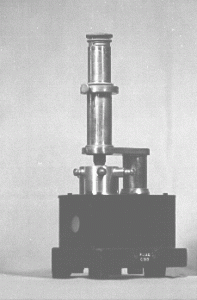
Cylindrical brass case with four brass terminals, windows on top and bottom (removable for 'spare') showing suspended needle inside, surrounded by four cross-connected plates. Mounted on a black box, with hole covered in frosted glass in wall, leading to a prism directing light through the bottom window. A swivelling microscope with scale (E. Leybold's/Nachfolger A.G./Coln - Rhein) also mounted for viewing the needle.
Designed by Prof. F.A. Lindemann for use in connection with photoelectric measurements of light in astronomical work (and also used to measure radioactive emission in an ionisation chamber). Operation is similar to that of a quadrant electrometer. It has a high sensitivity and a stable zero, and does not require levelling. The needle is attached to a torsion fibre, which is fixed under tension to fix the centre of rotation. The voltage across the plates (which replace the quadrants) induces a force on the needle, which in equilibrium is balanced by a restoring force from the fibre. Since no mirror is needed, moving parts only have a small inertia, therefore keeping the period low. An earth terminal eliminates problems with stray capacitance.
M.L.
